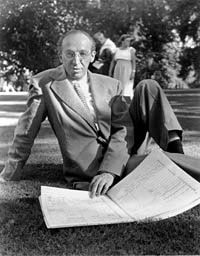|
Strictly from a symbolic point of view, it was thoughtful of Aaron Copland to be born in November of 1900 - a month that brings us a quintessentially American holiday, and a year that suggests the promise and vitality of a new century: the American century, as it's been called.
Over the years, he's been hailed as the American composer by everyone from Leonard Bernstein, who said, "He's the best we've got," to Spike Lee, who reached for Copland scores to create the soundtrack for He's Got Game. What is it that's so American about Copland? Some have located it in a mood. In the optimism that seems to pervade the Third Symphony, written during World War II, or the "zip" that propels the Outdoor Overture. Or, in the "plainness" of his musical manner, which can be seen as a musical equivalent for everything from Shaker design to Copland's own personality. But beyond these metaphors, it's possible to perceive "American" musical thumbprints in Copland's style - musical traits and devices that link Copland with other American musicians, and that have the power to evoke American metaphors of their own. Folk
Music But it doesn't stop there. Copland will take folk songs, disassemble them and recombine them every which way. Copland uses the folk song "If He'd Be a Buckaroo" in two layers of counterpoint with itself ("triple canon"). The resultant "dissonant" harmonies belong both to modernism
and to the unschooled folk tradition. Sure, they could be prettied up
- but how American would that be? Textures
This can also work "horizontally" as well as "vertically."
Listen to the very end of Appalachian Spring, where the high
notes of the solo flute float above the very lowest notes of the harp,
for a good example. Hymns Jazz Rhythm Read what the experts say about Copland | Copland 10x10 Home
|
||||||
MPR Home | News | Music Collection | Events | Radio Listening | Your Voice | About Us | Support Us | Help ©2005 Minnesota Public Radio | Terms of Use | Privacy Policy |
